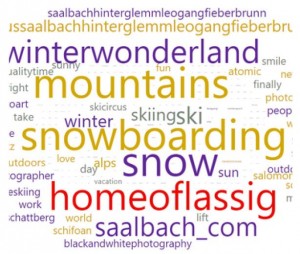An eTourism Research project by: Veronika Surkic, Richard Mükisch, Elza Kaiumova, Oguzcan Gumus 
A large proportion of people use social media to find travel ideas. In this blog article, it is made clear how important it is to know which brand image the customers have of the respective company or the destination to be traveled to. It is much more common with just a few clicks on Instagram to search for a destination and make about experience and impressions there. We illustrate with the help of a content analysis on Instagram why this can be of great benefit in the private sector. According to mediakix, Instagram is one of the most used social media platforms in the world.
The number of Instagram followers is soaring by the second. According to the Influencer Marketing Survey, Instagram has been nominated as the most strategically important social media channel for influencer marketing by 2019. It would be reckless not to leverage such a “live” platform for the interests of one’s business, considering that the major social networks have long been used more than successfully to promote brands. Naturally, the tourism industry has not missed out on this opportunity to promote tourist destinations.
Importance from the economic point of view
According to Varkaris (2017), it is a fact that customers form a credible picture of their future destination. However, to distance ourselves from the theory here, let’s take a look at the business figures. According to Brandwatch (2020), by 2020 there were approximately 1 billion monthly active users and 95 million photos are generated on a daily basis. It is also clear in this context that user-generated content is considered very honest and reliable by customers. (Mangan, 2021) Furthermore, we can make use of financially important key figures such as return on investment via the reputations of social media. The Dunloe Hotel & Gardens has already taken its steps in this regard, incorporating social media into its financials, marketing and customer support (Adrian Stehr, 2021).
The promotion of tourist destinations is time-consuming and requires a large-scale analysis. The positive leverage the range of the DMO, UGC content can be used which is not covered by the DMO but still matches the desired Image.
This should be repeated and carried out over certain periods and not only in the initiation phase. Social media marketing professionals know how much effort and what impact actions and campaigns have on customer buying power. The wise man learns from the mistakes of others” is one of the reasons why we have conducted a case study of Ski Resort Saalbach Hinterglemm. This aimed to analyze the content, which was posted on Instagram. As a basis for this, data from Destinations Management Saalbach and User Generated Content, which was collected in the period of the winter season 19/20.
As the proverb says, “Only a fool learns from his own mistakes. The wise man learns from the mistakes of others”
Recommendations & Research Approach
To conclude the theoretical part here, we can confirm that the brand image has been adopted by users in their content. This is clearly illustrated in the following example using an image of a Word Cloud. The basis for this example is the image description of each user. To increase the credibility of the brand and thus the intention of the users, the story offered by the users should match the one offered by the DMO. This also increases the rate to visit the destination again or recommend it to others (Jiménez-Barreto et al., 2020).
Basic word cloud overview of the DMO textual descriptions shows that the topics are winter and snow, promotion of Salzburgerland and Skicircus areas, the slogan ‘Home of lässig’ and the events FIS Alpine World Cup in Saalbach and the Freeride World Tour.
As a recommendation from our side, we can pronounce the following. The first step should be market research on the brand image of the destination. In the next point, the exact wording of a # or slogan should be determined. This must then be memorized in the minds of users and guests over a period of time. After several campaigns have been completed, the final step of data analysis can be done to show how successful the market research and marketing campaigns have been in the past.
This was our Research Workflow:
Our research design was quite complex, as we analyzed image data and textual data with machine learning approaches.
Click image to enlarge
Sources:
Adrian Stehr, M. B. (20. 01 2021). Killarney Hotels Limited. Von The Dunloe Hotel & Gardens: https://www.thedunloe.com/
Larsen, H. (2018, June 1). The ‘mental topography’ of the Shanghai city brand: A netnographic approach to formulating city brand positioning strategies. Journal of Destination Marketing & Management, pp. 90-101.
Jiménez-Barreto, J., Rubio, N., Campo, S., & Molinillo, S. (2020). Linking the online destination brand experience and brand credibility with tourists’ behavioral intentions toward a destination. Tourism Management, 79, 104101
Lund, N., Cohen, S., & Scarles, C. (2018, June 1). The power of social media storytelling in destination branding. Journal of Destination Marketing & Management, pp. 271-280.
Mangan, M. (2021, January 21). Hospitality Net. Retrieved from Hospitality Net: https://www.hospitalitynet.org/news/4071855.html
Varkaris, E., & Neuhofer, B. (2017, January 1). The influence of social media on the consumers’ hotel decision journey. Journal of Hospitality and Tourism Technology, pp. 101-118.


